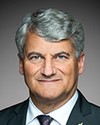Thank you, Mr. Chair.
Good morning everyone.
It’s a pleasure to join the members of the Standing Committee on Environment and Sustainable Development to discuss the 2023‑24 Main Estimates, as well as the 2022‑23 Supplementary Estimates (B) and (C) for my portfolio, which includes Environment and Climate Change Canada, the Parks Canada Agency and the Impact Assessment Agency of Canada.
With me today are Chris Forbes, the new Deputy Minister for Environment and Climate Change Canada; Linda Drainville, Assistant Deputy Minister Corporate Services and Chief Financial Officer for Environment and Climate Change Canada; Catherine Blanchard, Vice President, Finance Directorate, Parks Canada Agency; Terence Hubbard, President of the Impact Assessment Agency of Canada; and Joelle Raffoul, Acting Vice-President, Corporate Services and Chief Financial Officer of the Impact Assessment Agency of Canada.
Before I get started, I would like to recognize that we are meeting on the traditional territory of the Algonquin Anishinaabeg, the original stewards of the lands we share today.
I take very seriously our responsibility to strengthen the nation-to-nation, Inuit-to-Crown and government-to-government relationship with first nations, Inuit and Métis, through respect, co-operation, partnership and recognition of rights.
I see this as critical to the ambitions and actions, throughout my portfolio, that we’re discussing today.
Let me begin with Environment and Climate Change Canada.
The department works in collaboration with Canadians across the country, with all sectors of the economy and society and all faiths, including 2SLGBTQIA+, racialized and vulnerable people of all ages and, importantly, indigenous peoples.
The department leads, supports, and enables ambitious actions on a wide range of issues and concerns domestically and abroad.
From tackling climate change and pollution and managing toxic substances to slowing the loss of biodiversity and protecting nature and species at risk, plus safeguarding Canadians through its weather and environment predictions, our government's success in this regard is vital to protect the health and well-being of Canadians, the economy and the environment.
Priorities that go hand in hand.
As you know, we are in a critical decade in which we will have to address the triple crisis of climate change, biodiversity loss and global pollution, in particular by plastic. This is a crisis that requires integrated and accelerated efforts if we want to avoid the most catastrophic impacts that threaten not just our standard of living, but also the future of humanity on this planet.
That is why the department is collaborating on a number of ambitious actions, such as achieving net-zero emissions by 2050, which is the best way to limit temperature increases to 1.5°C.
It's helping to create the conditions necessary for protecting at least 30% of lands and waters in Canada by 2030.
Scientific research shows this is the minimum that’s needed to address the dual crisis.
And as members of the committee know well, when it comes to the environment, collaboration defines success.
That is why I'm pleased to note that the department played a vital role in helping to ensure that the global targets align with Canada's target in the Kunming-Montreal global biodiversity framework negotiated at COP15 last December in Montreal.
To enable continuous progress that will enable us to achieve our goals, Environment and Climate Change Canada’s 2023‑24 Main Estimates amount to $2.4 billion, a 24% increase over last year. This includes about $1 billion for planned operating expenditures, over $100 million in planned capital expenditures and more than $1.2 billion in grants and contributions. Total statutory costs amount to $112 million.
In sum, the 2023‑24 Main Estimates represent a net increase of approximately $478 million over the total 2022‑23 Main Estimates.
This increase is primarily due to new funding for nature-based climate solutions, the recapitalized low-carbon economy fund and the low-carbon economy fund re-profile. New funding will help to protect old-growth forests by advancing urgent protection of vital ecosystems, wildlife habitats and species at risk, and by protecting carbon stores in these areas.
Recapitalizing the low-carbon economy fund will help support projects to reduce greenhouse gas emissions that both contribute to Canada's 2030 targets and align with goals for net-zero emissions by 2050.
This fund will support the renewal of the existing streams—the Low Carbon Economy Leadership Fund and the Low Carbon Economy Challenge Fund—and add two new streams: the Indigenous Leadership Fund to support Indigenous-led clean energy and energy efficiency projects and an Implementation Readiness Fund to support applicants advancing proven low-carbon technologies.
Through the 2022‑23 Supplementary Estimates (B) exercise, ECCC increased its reference levels in the amount of $189.7 million. This update included new funding for the highly successful United Nations Convention on Biological Diversity, COP15.
Funding sought also included initial requirements for the recapitalized Low Carbon Economy Fund as well as funding for the implementation of the next phase of the Oceans Protection Plan and for advancing a circular economy for plastics in Canada.
Mr. Chair, ECCC also participated in the 2022‑23 Supplementary Estimates (C) process in order to drive further progress in the fight against climate change and to protect and conserve nature.
Through this process, the Department’s reference levels were increased by a net amount of $15.8 million bringing the Department’s total financial authorities to $2.3 billion in 2022‑23. These Estimates included a funding transfer from Foreign Affairs, Trade and Development, to support the Partnership for Market Implementation as well as funding for the British Columbia Old Growth Nature Fund.
Mr. Chair, let's turn to Parks Canada.
For 2022‑23, Parks Canada received...






